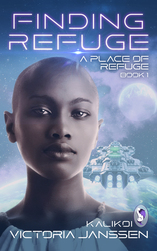Fiction:
The Iron Children by Rebecca Fraimow will be out in early April; I read an ARC via Netgalley. In this novella, two countries are at war. The larger and more powerful Levastani want to take back the smaller country, which split off long ago due to their Celesti religious faith. The Celesti faith includes a strong belief in service, and in true speculative fiction fashion, some of their nuns gave up their bodies to become armored warriors who can telepathically control the bodies of armored Dedicate soldiers. If the Sor bodies are killed, usually the Sor can be moved into a new body. The Dedicates mostly originated as children orphaned by the war, who are now sealed within armor with an extra set of arms to aid them in battle, and a chip of “godstone” in their necks that allows the nuns, the Sor-Commanders, to control them at need. The Dedicates cannot remove their armor, and when they are killed, it is permanent. The story opens with a young nun in training, Asher, accompanying her Sor-Commander and a small group of Dedicates to the front, but then disaster strikes and Asher is left in command, relying heavily on Sergeant Barghest for advice and reconsidering all that she thought she knew about her world. Asher, Barghest, and a traitor in the group are all narrators at different points; their deep characterization enriched the worldbuilding and various ethical concerns of this intriguing secondary world. I would happily read about these characters again, to learn how their experiences in this story change them and their society.
Mai Tais for the Lost by Mia V. Moss is a noir murder mystery novella, set in an undersea habitat for the rich on post-apocalyptic earth. Absolute best part: a sarcastic octopus who can talk to humans. Narrator Marrow, a detective who usually uncovers infidelity, is thrust into a more dangerous world when her older brother is murdered. Marrow, the child of domestic workers, was adopted by a wealthy family after her family was accidentally killed, to avoid bad press. Raised in a world of decadence and partying, she’s still looked at askance and constantly navigates societal borders. The worldbuilding was a lot of fun, especially details like fashionable “mer-suits” and ocean-themed food and drink; the mystery takes a while to get going, and felt bigger than the length allowed for it. I wanted to know more about the androids/robots (both words were used) who had Artificial Intelligence; so far as I could glean, AI was created and owned by corporations, but I wanted a lot more about that, and related ethical concerns, than I got. That aspect of the story intrigued me. An epilogue gave me hope for a possible sequel.
Fanfiction:
This month,I read a number of of fanfictional Queer Eye episodes, in which the Fab 5 from the Netflix show do makeovers on an assortment of fictional characters. These are the ones I enjoyed most.
Queer Omens by Lurlur crosses over Queer Eye with the television version of Good Omens. Post-Armageddon-that-wasn’t, Crowley kidnaps the Fab 5, who don’t make over Aziraphale’s bookstore, but do help the angel and the demon with relationship issues.
A Lifetime of After by Casloveshisfreckles is both a crossover and an alternate universe. The Fab 5 makes over Castiel Novak, a board game designer, who was nominated by his best friend and roommate, elementary school teacher Dean Winchester, and foster their romantic relationship. This is an alternate universe version of the show Supernatural, with no supernatural elements.
Queer Eye for the Staten Guy by lousy_science features Dominick “Sonny” Carisi Jr. from Law and Order: Special Victims Unit. I’ve seen maybe a couple of episodes of that show, from early on in its run, but I was able to follow the story anyway. Sonny recently received his law degree, but his loving Italian-American family says he’s been distant from them since, and hasn’t wanted to celebrate his achievement. Sonny, meanwhile, has been dealing with several emotional issues, which the Fab 5 help him to overcome. There’s an epilogue in which he gets together with the person he’s been crushing on.
Queer Eye for the Spider Guy by sahiya is also both a crossover and an alternate universe. Tony Stark survives Thanos and has become even more of a father figure to Peter Parker, whose identity has recently become public now that he’s a PhD student at NYU. Peter’s having trouble balancing his Spiderman duties with everything else, which led to his breakup with MJ, and finds it difficult to accept help from his loved ones, even his Aunt May. The Fab 5 help Peter to go from “Spider-mess to his Spider-best!”
Queer Eye For the Science Guy by heyjupiter features Bruce Banner, who lives in Avengers Tower after helping fight off the Chitauri invasion. Bruce only has two pairs of trousers, all his t-shirts used to belong to Tony Stark, and he forgets to leave the building for weeks at a time. The Fab 5 have their work cut out for them…plus they want to know what’s up with the Science Bros relationship.
Starting a New Chapter by lilithilien crosses Queer Eye with The Old Guard (movie version). After his exile from the group, Nile has recommended Booker for a makeover. At least he knows how to cook. There are many puns on books, reading, pages, etc..
This one is not a crossover! Locked Out by JustLookFrightenedAndScuttle is a Check Please! AU in which Jack Zimmermann takes a year off before signing with the Providence Falconers, rather than going to college. He meets Bitty at the train station, where Bitty’s just locked himself out of Lardo Duan’s car. They hit it off because of course they do; this is a lovely romance that leads to Bitty coming out to his parents and grandmother, and Jack’s father getting interested in baking.

